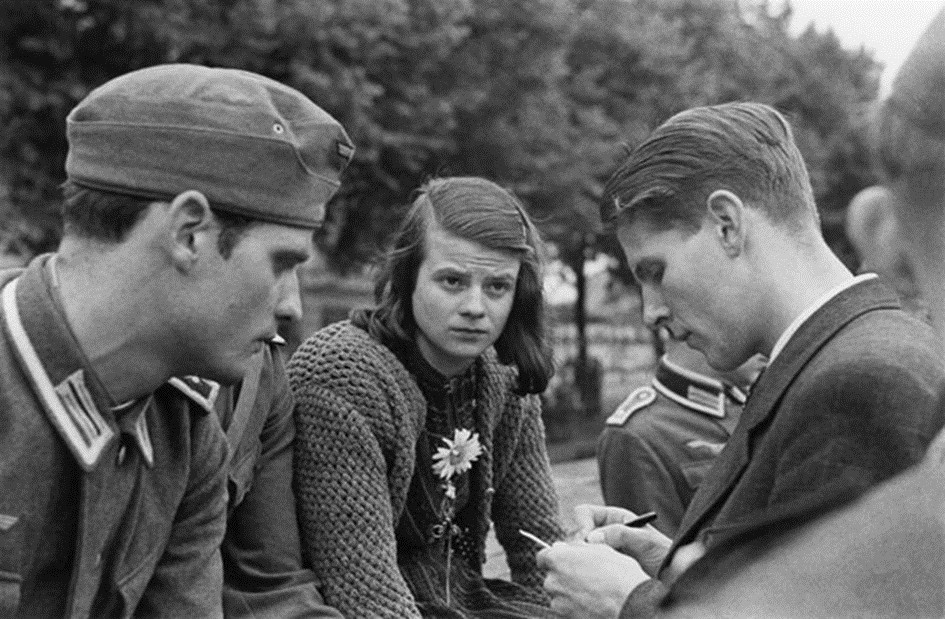The story of Sophie Scholl and the German Resistance movement "The White Rose" continues to inspire and encourage people today. It is not only a testimony to the fight against the Nazi- Regime, but also a demonstration of the resilience and courage of young people who risked their lives to fight for freedom.
Born on 9 May 1921, Sophie Scholl grew up in Forchtenberg as the fourth of six children of an upper-middle-class family. When she turned 10, the family moved to Ulm, where her father started work as a state auditor and tax consultant. After the Nazis came to power, Sophie Scholl, just like most of the German youth at that time, was excited to follow the National Socialist youth movement. However, after Sophie's brother Hans was arrested for being a member of the forbidden scout’s movement “Deutsche Jugendschaft 1.11.”, her attitude towards the regime started to change, and she began to disassociate with the National Socialist Party.
When Sophie Scholl's brothers and her boyfriend Fritz Hartnagel were sent to the Eastern Front following Hitler's invasion of Poland, her doubts about the regime grew. She moved to Munich in May 1942 to study biology and philosophy, whilst her brother, who returned to study medicine, had already begun to actively rebel against the system. Witnessing the crimes committed in Poland and Russia, Hans and his friends began printing flyers in Munich in June 1942 and distributing them around the university campus. Over time, more and more students joined their Resistance movement, including Sophie Scholl.
The movement would soon become known as the "White Rose". The core group consisted of the Scholl siblings and their fellow students Alexander Schmorell, Willi Graf, Christoph Probst, and Professor Kurt Huber. Together they distributed six pamphlets, speaking directly to their fellow citizens:
“Our current ‘state’ is the dictatorship of evil. We know that already, I hear you object, and we don’t need you to reproach us for it yet again. But I ask you, if you know that, then why don’t you act? Why do you tolerate these rulers gradually robbing you, in public and private, of one right after another, until one day nothing, absolutely nothing, remains but the machinery of the state, under the command of criminals and drunkards?” (Third White Rose Pamphlet)
The movement's call for action was very successful, and in a short period of time, the White Rose managed to build up an extensive network of supporters throughout Germany.
With the growing success of their actions, the group's self-confidence increased as well. Following the German army’s defeat at Stalingrad, dissident voices at universities were becoming louder after students had been publicly labelled as war resisters. This encouraged the White Rose to distribute the leaflets directly in person and write slogans such as "Down with Hitler" and "Freedom" on the walls in Munich.
Whilst Hans and Sophie were distributing the sixth pamphlet in the central hall of the University on 18 February 1943, a janitor witnessed the action and reported the two students to the Gestapo, who had them arrested immediately. Christoph Probst was arrested shortly after, as his name was mentioned in the draft of the seventh pamphlet, which Hans was carrying in his bag when he was arrested.
During a show trial, Sophie, Hans and Christoph took all the blame for the actions of the White Rose, trying to protect their friends. However, their attempt failed, and Willi Graf, Alexander Schmorell and Kurt Huber were arrested in the same month. After a half-day trial, Sophie, Hans, and Christoph were sentenced to death. In a final question, Sophie Scholl was asked whether she was aware of her guilt. Her response was clear: She was still fully convinced that she had done the best she could for her nation. She did not regret anything and would now bear the consequences of her actions.
On 22 February 1943, Sophie and Hans Scholl, as well as Christoph Probst, were executed by guillotine. After their deaths, their story remained hidden in Germany. However, the actions of the White Rose quickly became known in the Allied countries. In Great Britain, the Resistance group's leaflets were printed, multiplied, and dropped over Germany by aeroplane.
Today, the story of Sophie Scholl and the White Rose is well-known all over Germany. Remembering the students' courage and convictions is a solemn testament to the fight against National Socialism. Today, the White Rose Foundation honours the Resistance and its participants, promoting the values of civic courage, individual responsibility and democratic consciousness, which Sophie Scholl embodied. The fight for freedom and peace was Sophie's greatest concern, and even if she did not live to witness it herself, her actions helped to defeat the Nazi Regime in Germany.
Sources
Sophie Scholl and the White Rose | The National WWII Museum | New Orleans (nationalww2museum.org)
Weiße Rose Stiftung e.V. - Weiße Rose Stiftung e.V. (weisse-rose-stiftung.de)
Vor 80 Jahren: Ermordung von Hans und Sophie Scholl | Hintergrund aktuell | bpb.de
